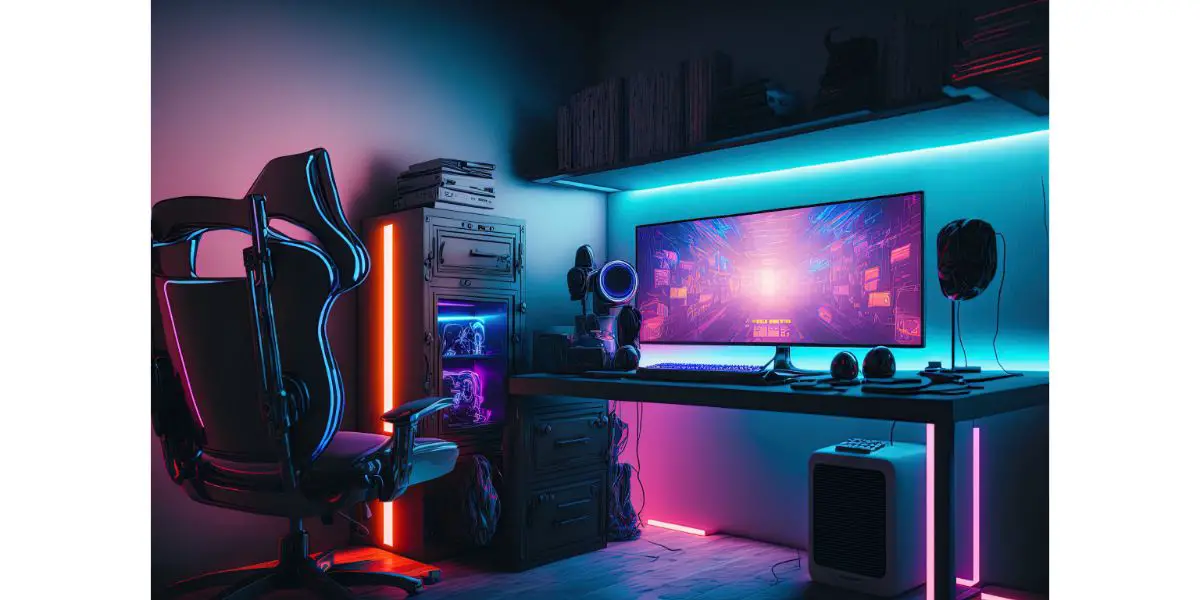Disclaimer: This post may contain affiliate links, meaning we get a small commission if you make a purchase through our links, at no cost to you. For more information, please visit our Disclaimer Page.
Frame rate, also known as frames per second (FPS), determines the quality of moving images on your computer. This particular aspect is essential for gamers, who need the movement of images to be smooth and natural in order to enjoy the full experience.
You may have heard some gamers claim that you should lower the resolution to increase the frame rate, but is this true? How does it work?
Table of Contents
The Link Between Screen Resolution and FPS
It is true that a lower screen resolution typically will result in a higher frame rate, especially in older computers. A high resolution means that there will be more pixels that your Graphics Processing Unit (GPU) will need to render for each frame. The more information the GPU needs to process, the fewer frames it will be able to generate in a second.
Consequently, a high screen resolution lowers your computer’s frame rate, resulting in an unsatisfactory viewing and gaming experience. Your GPU will struggle to render images of high quality fast enough.
Gamers need a high frame rate to play the games as it was intended. The more images they can see in a certain amount of time, the more information they get, and the more they can prepare for the next move. If you’re playing a competitive game, this can become a massive problem.
A solution, in this case, would be to lower your screen’s resolution. The overall quality of images will go down, but the movements will be much smoother, which is essential for a video game.
What FPS Really Depends On
While we’ve mentioned above that the screen resolution affects the frame rate, the truth is that the two of them are not exactly connected the way you would think. The GPU links the two of them together.
The frame rate depends on how powerful the graphics unit is. If you have an old computer with an old graphics card, you must choose between a high resolution and a high frame rate because the GPU can’t handle them both.
However, suppose you have an excellent quality GPU with a high capacity. In that case, you may enjoy high-resolution images and a high frame rate at the same time without sacrificing either of them.
As you can see, the GPU is the most important aspect in this situation. If it doesn’t have enough power, it cannot render a large number of pixels for many frames in a second.
Difference Between Resolution and FPS
To understand the relationship between resolution and FPS, knowing what they are and how they work is essential. Although both have to do with image quality, they have very different definitions.
Resolution
Resolution is the total number of pixels that compound the images on your screen. The more pixels there are, the more details you can see in your image. A higher resolution means a crisper, higher-quality image. Some common resolutions are:
- 3840 x 2160 (4K)
- 2560 x 1440 (Quad HD)
- 1920 x 1080 (Full HD)
- 1280 x 720 (HD)
- 640 x 480 (SD)
Naturally, a higher resolution also means more work for the GPU. A high number of pixels needs much more power to generate than a standard resolution. This is why it takes longer to open high-resolution, 4K, or Full HD images compared to standard definition ones.
Frame Rate
On the other hand, the frame rate determines the number of frames displayed on your screen for one second of the video or animation you’re watching. The more frames you can see on the screen for one second, the smoother and more natural the video will be. Typical frame rates for film and videos include:
- 15 FPS
- 24 FPS
- 30 FPS
- 48 FPS
- 60 FPS
Video game frame rates can be higher, all the way up to 240 frames per second. The more frames per second your GPU can generate, the more information you get from the game or the video. Understandably, the GPU needs more power for higher frame rates, so it will work much harder for 60 FPS than it would for 30 FPS.
Which One Matters More?
As we have just explained, the resolution determines how detailed and crisp the image is on your screen, while the frame rate determines how many frames your computer can display in one second. Both require the GPU to work harder for higher quality, so you could say that they compete for GPU capacity.
So, which of these two matters the most? Well, there is no definite answer to this particular question. It all depends on what you’re using your computer for and what you personally want to prioritize. For gamers, the frame rate is usually more important.
If you use your computer for typical browsing, working, and watching videos, you probably won’t have to make a decision at all. Your GPU will be able to handle your activity with no problem unless it’s very old.
If you like gaming, you should prioritize the frame rate. As much as you want crisp images and a pleasant viewing experience, the frame rate usually plays a bigger role in a pleasant gaming experience. With a higher frame rate, you get more information from the game because you can see sudden movements much more quickly.
This is especially important for competitive games, where having a quick reaction time can make the difference between winning and losing the match. For slower, single-player games, having a high frame rate is not as critical.
Is It Possible To Have Both High Resolution and High FPS?
Both resolution and frame rate are important for the quality of your viewing or gaming. Sometimes you need to choose between the two, but is there a way to enjoy both high resolution and high frame rate?
It is possible to view videos or play games at a high resolution and high frame rate at the same time if you have a powerful enough graphics unit. As mentioned above, the GPU is the real factor affecting this relationship. A high-quality GPU would allow you to play without making compromises.
If you have a new and high-performing GPU, you won’t have to make any compromises. However, you don’t need a super powerful GPU for an enjoyable experience. Most GPUs nowadays can handle a pretty good frame rate while maintaining a relatively high resolution.
How Can I Increase the FPS?
While a lower frame rate is acceptable for some games, other games will ask for higher FPS. In that case, you could be tempted to upgrade your graphics card. Replacing your GPU with a new, more powerful one could help you increase the FPS while maintaining high image quality.
Understandably, not everyone has the chance to replace the GPU whenever it’s not performing as well as it should. Changing the graphics card on your computer costs you money, time, and effort. Moreover, if you have a laptop, it’s pretty much impossible to do so. Is there any other way to increase the frame rate?
Besides changing your GPU, you can increase FPS by reducing your screen’s resolution. This is an easier and cost-free way of getting an acceptable frame rate with the existing GPU. Reducing the resolution gives your GPU a chance to render more frames per second.
How To Reduce Image Resolution on Your Computer
Whenever you feel the game you’re playing needs to be a bit smoother, you can sacrifice some resolution for a better frame rate. This doesn’t require a special set of skills or tools, so anyone with a basic knowledge of computers can do it.
For a windows computer, follow these steps to lower the screen resolution:
- Go to the Search bar, type Windows Display Settings and open it. Alternatively, you can right-click on the desktop and then choose Display Settings.
- Go to Advanced Display Settings.
- Find the area that allows you to choose the screen resolution.
- Choose the resolution you want. Be careful not to lower it too much.
- Select Apply.
You may or may not notice the difference immediately, but try going back to your video game and see if you can see smoother and more natural motion. It has been proven that by reducing the resolution from Full HD to 1600 x 900 may let the GPU generate 15 to 20 more frames per second.
It’s important to remember that an increase or decrease in the resolution can only affect the frame rate to a certain extent. Once your GPU isn’t struggling to keep up anymore, the frame rate won’t change, no matter how much you lower the resolution. This means you’re playing using the maximum number of frames per second the game allows.
What To Do When You Can’t Lower the Resolution
If you don’t want to choose between good quality images and a high frame rate, or you simply can’t lower the resolution, there are other settings you can adjust to increase the frame rate.
These settings help create realistic and high-quality images, but you can sacrifice some of them for a higher frame rate. Keep in mind that you may not be able to see a significant difference in FPS by adjusting these settings, but the changes may still affect your gameplay in a positive way.
Here are some alternative solutions that you can try in order to increase the frame rate without lowering the resolution:
Remove Unnecessary Programs
Before you turn to gameplay settings, start by trying the most straightforward solution: clean up your computer. If you have a lot of programs open on your computer, they can affect the overall performance and, consequently, the frame rate of your games.
Open the Task Manager and see if any programs are running in the background. Close any unnecessary ones and see if it makes a difference.
Turn Off Motion Blur
Motion blur is a setting that adds a blur-like effect to the animations. Its purpose is to make the image more realistic and hide glitches and imperfections in the game. This effect is sometimes unnecessary and, in the worst case, downright annoying.
Most importantly, motion blur adds an extra load to the GPU. If you turn this setting off, you can help the GPU render more frames faster.
Lower the Visual Quality
Most games include shaders, which add a realistic quality to images and make the images darker and grittier. However, these shaders require a lot of GPU power to be rendered, so they may lower the frame rate.
You adjust the shaders and light quality so that they don’t stress the GPU as much, or you can simply turn them off. Some gamers even prefer playing without shaders since they can see everything better without the added darkness.
The same thing applies to other visual settings. Things like textures, lighting, and render distance all put a load on your GPU. If you don’t want to tweak each of these things individually, most games have a slider that lets you change all of them at the same time.
Turn Off Vertical Sync
Vertical sync is responsible for syncing your game’s frame rate with your monitor’s refresh rate. It was developed to prevent the monitor from displaying different frames at the same time.
This feature helps prevent issues like screen tearing, but at the same time, it adds to the load of the graphics card.
If you have no issues with screen tearing, you can turn VSync off. You won’t be able to see much of a difference, and you’ll lighten the load on the GPU. As a result, the graphics card will be able to handle a higher frame rate.
Conclusion
Screen resolution affects the frame rate of your screen because it uses up the capacity of the computer’s GPU. A typical graphics card can struggle to handle high resolutions and frame rates, so a better image quality usually means a lower frame rate, especially for video games.
Most gamers prefer to sacrifice a bit of resolution for better FPS, but it depends on personal preference.



